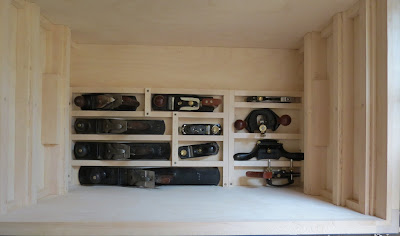 One of the interesting--and beneficial--aspects of building a tool chest is you have to decide what tools make the cut. I own at least one of the following bench planes: 3, 4, 4 bevel-up low angle, 5, 5 1/2, 6, 7, as well as 2 block planes. After giving it a lot of thought, I decided that I would do without the 3 and the 6. I still own them and others, but I haven't used them.
One of the interesting--and beneficial--aspects of building a tool chest is you have to decide what tools make the cut. I own at least one of the following bench planes: 3, 4, 4 bevel-up low angle, 5, 5 1/2, 6, 7, as well as 2 block planes. After giving it a lot of thought, I decided that I would do without the 3 and the 6. I still own them and others, but I haven't used them.Many woodworkers simply set their bench planes on the bottom, but I decided to make dividers. I do intend to transport my tools in the chest and I also don't want to bang them into each other as I use them. It was a simple matter to attach some (removable in case I change my mind) maple strips to the bottom. I store my specialty planes and cabinet scraper next to them in the same manner--shoulder, router, cabinet scraper, plow.
Removing planes from the chest is a quick and easy one-handed operation accomplished without moving anything above them. Many woodworkers are concerned about bending over, but you put one hand on the edge of the chest and reach down with the other to grab the plane. It's very comfortable.
One comment you often read is that tool chests are too heavy to lift anyway, so the supposed advantage of chests in moving your tools isn't borne out. I can go from having my chest fully loaded to what you see in the picture in less than one minute, and removing the planes would take a minute more. I could easily load the chest into my pickup alone and replace all of the tools in short order, less than five minutes total.
You'll notice three rails along each side that get progressively narrower. Stay tuned.

What is the weight of your unloaded tool chest (or with just the planes in it?)
ReplyDeleteI like my #3, so am somewhat surprised that this would miss the cut. But then I even like a junker #4 that I use for rough planing on suspect/reclaimed wood.
Matt
Matt,
ReplyDeleteI don't have a means of weighing it. It is easily within the average woodworker's ability to lift it into a pickup empty. I know Chris Schwarz favors pine for its weight, but I'll bet the weight of mine compared to a pine chest of the same size is immaterial. The contents weigh much more than the chest. I think ease of transportability is more a function of how easily you can remove the contents for loading and unloading than how much the chest weighs. I'm happy with under five minutes.